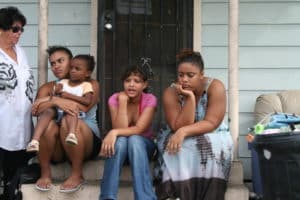Before the Community Conversation I… “thought that there were few solutions to the eviction epidemic in the US.”
Now I…“realize there are many ways to institute change and policy to eradicate homelessness and decrease evictions nationwide.”
—Discussion Participant, April 2019
These words from our first Community Conversation on the National Building Museum’s Evicted exhibit are just the sort of response we hoped for when the Museum and the Interactivity Foundation began collaborating on civic engagement programming surrounding the exhibit. Let’s face it, the eviction epidemic, and the broader issue of housing instability, is a downer. How could we engage exhibit visitors in an exploration of the complexity of these topics without leaving them hopeless of any path forward? That was the question that set us on our way.
The first stop on the way was to convene a pair of exploratory discussions with interested K-12 faculty members. Our intent was twofold. First, we wanted to test an approach to facilitated small-group discussions to dive into the complexity of eviction and to collaboratively generate alternative ideas for addressing the eviction epidemic. Second, we wanted to use those discussions to develop a discussion guide for classroom discussions—something educators could use when visiting the exhibit.
Andrew Constanzo, Director of P-12 programming, and I worked together to convene the faculty discussions over a pair of evening sessions. The discussions were rich—providing a successful test of our discussion approach, as well as generating enough material to help us co-create a Teaching Guide for grades 6-12. The guide includes: topical information to set the context for the discussions, “how-to” guidance about facilitating and participating in an exploratory discussion (in contrast to a debate), and a series of prompts and discussion activities to focus the discussion. We worked with Caitlin Miller, Senior Educator of P-12 Programming, to test the guide as part of the training the museum’s teaching staff to facilitate student conversations.
The second stop was to engage members of the public directly in conversations, using the approach embodied in our discussion guide. Patrick Kraich, the museum’s Senior Educator, took care of the logistics and set-up, and I took care of the discussion facilitation. Together we hosted a pair 90-minute small-group Community Conversations, the first with five participants, the second with nine.
These Community Conversations followed the trajectory we set out in the guide for educators. The first half of each conversation explored different dimensions of housing, eviction, and housing instability. The second half shifted to imagining different possibilities to address housing instability. We did this by using the “history of the future” approach. I asked them to imagine we were in a future when the eviction epidemic was no more. It was up to the participants as individuals to picture what this might look like. They might imagine it meant there were no longer any evictions—or that they were much less frequent than they are today. I stressed that this was a time to be bold and to imagine possibilities beyond the status quo. Once we talked about some of their visions of the future, I asked them to consider the building blocks from our own time—realities that could be built upon to reach their visions of the future.
This overall trajectory of the conversation helped to shift the mood beyond the sense of being mired in an intractable situation to a more optimistic projection of possibilities. We’re hopeful about the prospects for such conversations and how they could create a sense of civic optimism—around this issue and others. We’re also hopeful about the prospects for collaborations between the Museum—and museums in general—and those of us working in the fields of civic engagement and dialogue and deliberation.



